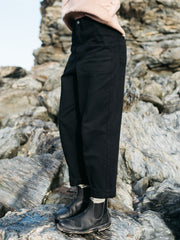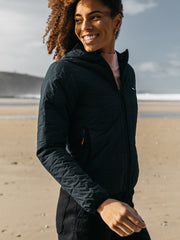We’ve been passionate about Wool since day one, and none more so than our Senior Design Manager, Rose Savidge. Following her trip to our long-term partner, Donegal Yarn, we caught up to talk about her visit, her enduring love of knitwear, and the importance of sustaining and celebrating this traditional craft.
Donegal Yarn: A Spinner's Story
31.10.23
4 min read
Words by Rose Savidge
Photography by David Gray
Rose and ambassador Noah Lane, having that 'kid in a candy shop' moment...
My passion for knitwear stems from early childhood. Growing up on a farm, I remember being enchanted by the machinery. All this big industrial kit with so much character and wonderful sounds and smells. I was only five or six when we left the farm – but that love, that fascination for machinery, that never left.
I went on to study textiles at Chelsea College of Art & Design, and we got to try everything before deciding what we landed on. I loved print. I still do, but it’s very digital now. Back then it was much more about pushing the inks through a screen, it was very hands on. And I loved knitting. But I fell in love with the machines first. The sound of them, the smell of them. I loved the way they worked – and being involved, the tactility.
Rose and Noah get hands-on with the raw wool.
Margaret keeps a close eye on the details in the finishing department.
Even when I first started my career I would go to factories where there were lines of old-school Dubied machines, and people behind them: click, click, clicking. Things have changed in the last twenty years or so. In the age of technology everything is so fast, automated. Stuff flies in and flies out, and a disposable consumer culture has come with that. Still, there remains a real craftsmanship to spinning, using machinery over 100 years old that’s doing its job as well as anything new and modern. For me, there’s real beauty in that.
I’ve also always instinctively looked to tradition for knitting patterns and techniques. Particularly those that came from seafarer families, passed down generations, that told real stories. Knitted by mothers and daughters while husbands and fathers were at sea, these hardy jumpers declared their love and support. And that’s why our knitwear feels so important at Finisterre. It's all about the heritage and craft. Creating knits that of course look great but are fit for purpose and made to last: knitwear that tells tales of old, built for stories yet to be written.
Aaron works in the carding room, untangling fibres to make them easier to spin...
... And Andreii keeps the old machines running smoothly.
Shop Our Donegal Yarn Jumpers
All of this nostalgia stirred in me ahead of our trip. I felt so excited about visiting our partners at the Donegal Yarn Factory, a team of traditional spinners Finisterre has worked with for over a decade. I’d been planning the trip for a while, and when it arrived it felt more like a holiday than a work trip.
When we got to the factory, seeing all these old machines and super-skilled people, I couldn’t contain my excitement. All these folk with decades of experience, craft masters that have trained to do these jobs and have a passion for these machines. There's not a lot of workmanship that exists like that anymore. Often, when you go to these types of mills, they’re struggling, because people don't want to do these jobs. But in Donegal it was a different story. People there feel really proud and honoured to produce Donegal Yarn.
Seamus is an old hand with decades of experience.
Hiding behind door number 2, the secrets of the wool mixing room...
And that's encouraging – that pride in the workmanship. Because more and more all people care about is how cheap something is. They’re not interested in where it comes from or how it’s been made. For me, it’s so important to keep shining a light on these skills and stories, and showing people that value means far more than price alone.
Meeting the team at Donegal Yarn was simply wonderful. Seamus is in his 70s, he’s been there forever. And Nora, who is in charge of all the colour – whenever I went into her room she wouldn’t let me go! She wanted us to develop a new colour together. At one point, when I was in a meeting, she even came over bursting with child-like enthusiasm to show me what she’d come up with!
And yet, the best was still to come. For those who don’t know, neps are the little flecks of colour you might see in a yarn that add texture and interest. Originally, wool spun in Donegal didn’t have neps but through a mistake in the spinning room in the olden days, the yarn got mixed. The result was the flecks of colour we call neps, which have become synonymous with the Donegal yarn we know and love today.
The wall of wool, helping map out new yarn colours...
... while Nora and Rose geek out over the rainbow of choices.
Nora took us through the whole process. Starting with the base colour of the yarn, next you pick the colour of the neps, then it all goes into a machine and up into a huge vacuum. It was like a beautiful snow dome of Merino Wool, there up on the ceiling, all the colours being mixed. Eventually the wool comes back with the right balance of base colour and nep flecks, ready to be put into a bale of yarn and then off into the spinning process.
It was incredible to watch. We almost danced. Grown adults came out of that room returned to childhood. Therapy by merino wool.
Spending time with the team in Donegal was like being with family. It felt like a group of people that really care for each other, and the product – and that’s so important. It’s also testament to the kind of relationships we build with our suppliers, finding these places where they have so much passion and skill.
Who wouldn’t want to work with people like that?
Shop our Women's Knitwear...
Shop our Men's Knitwear...



































































































